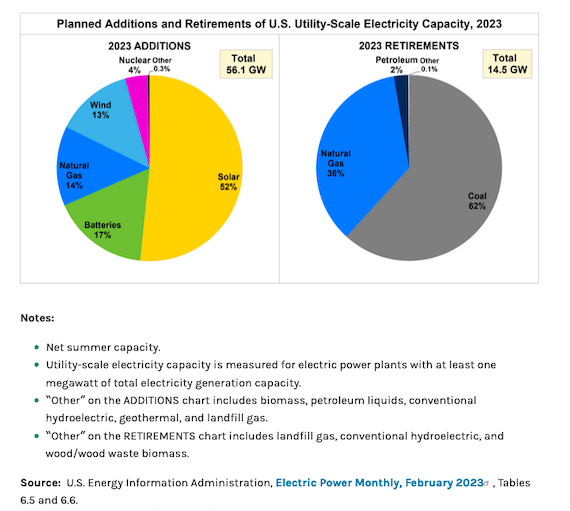Ann Arbor (Informed Comment) – The Department of Energy has announced that that in 2023, 82% of new additions to electricity generation capacity in the United States will come from wind, solar and battery, and 86% in total will come from non-fossil fuel sources. Of fossil fuels, only fossil gas will provide new capacity, but only 14% of the total. The Department expects 56.1 gigawatts of new capacity to be added, though 14.5 gigawatts will be retired, all of it from fossil fuels. So net new power coming on line is 41.6 gigawatts.
While these statistics are full of good news, they are woefully inadequate to the proportions of our current global crisis. We just saw the tropical island of Maui burned to the ground, and a tropical storm lashed southern California. This is a very rare event because the Pacific Ocean used to be too cold to sustain a hurricane. Now its waters have heated up. The water at Huntington Beach is like 66 degrees F. When I was a kid living in California and we went to the beach in the summer, the water was cold. Canada’s forests are on fire. A heat dome caused the temperature in Phoenix AZ to reach the point that people who fell on the sidewalks got third degree burns. The climate is shouting at us to COOL IT, and then we get in our gasoline cars and drive to an office heated by a coal plant, all of which is boiling the planet. We need a Manhattan Project to win the climate war and we need to throw all our resources into it. Now.
So back to green energy. At the moment, the US has 73.5 gigawatts of solar and 141.4 gigs of wind. So wind has been built out much more than solar to date. But that trend may be changing in a big way, since the cost of solar panels keeps plummeting. This year, utility solar will account for an absolute majority of new power, at 52%. That is just over 29 new gigawatts of solar, which will take us to nearly 100 gigs from that form of energy. It is actually more, since the DoE does not count rooftop solar.
California alone plans to add nearly 4 gigawatts of new solar this year.
Wind will account for 13% of new power capacity nationally this year, a little over 7 gigawatts, taking us near to the 150 gig mark for that form of energy. Wind provides about 10% of US electricity annually. New wind installations had declined during the past couple of years for a variety of reasons, including supply line problems stemming from the COVID-19 pandemic and high commodity prices caused by post-COVID inflation,
The US wind turbine industry is revving back up now, however, because of President Biden’s Inflation Reduction Act, which is actually a green energy subsidy. The same is true of solar installations. Rooftop solar installations can receive a 33% discount in the form of tax credits.

H/t DoE.
In a new and promising development, 17% of added power generation capacity this year will come from batteries for stored energy. The sun doesn’t shine at night and the wind doesn’t always blow, so the only way to make full use of these two forms of renewable energy is to capture some of the generating capacity for use later. By the end of Q1 this year, the United States had 10.8 gigawatts of battery storage capacity. But it seems that we will nearly double that, adding 9.5 gigawatts of battery in 2023 alone.
California, a leader in this field, has 5 gigawatts of battery storage, a new capacity that has helped the state avoid brown-outs and black-outs. Texas has 2.2 gigawatts of battery storage. These two renewables giants account for the bulk of total US capacity in this area.
Despite the prolonged and intense heat dome of this summer, itself caused in large part by humans burning gasoline, fossil gas and coal, Texas has avoided electricity outages, in large part because of its renewables and battery capabilities. The Republican legislators, however, are planning to disadvantage renewables in favor of fossil fuels, as a result of the extra oil money they have been finding in their coffers. That may make you mad at the lawmakers and the lobbyists of Koch Industries, ExxonMobil and the other ghouls seeking their 30 pieces of silver for betraying Mother Earth. Believe me, you’re not nearly mad enough.
The good news is that mere state legislation is unlikely to overrule both market forces and federal subsidies. The Department of Energy reports that nearly 100% of capacity being retired is from coal (62%) and fossil gas (36%).


 © 2025 All Rights Reserved
© 2025 All Rights Reserved